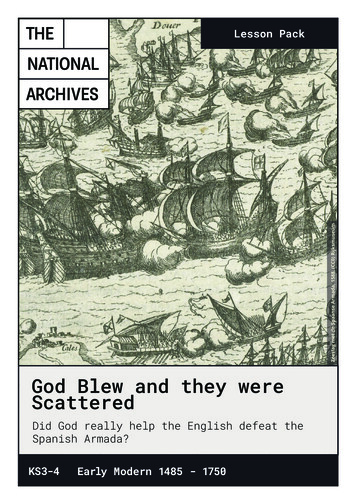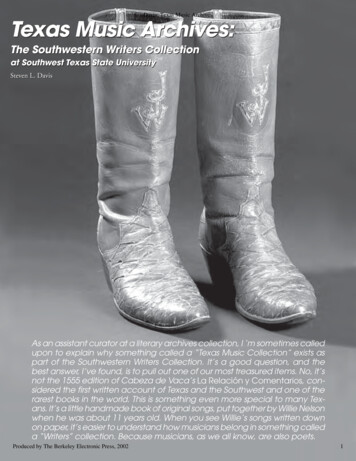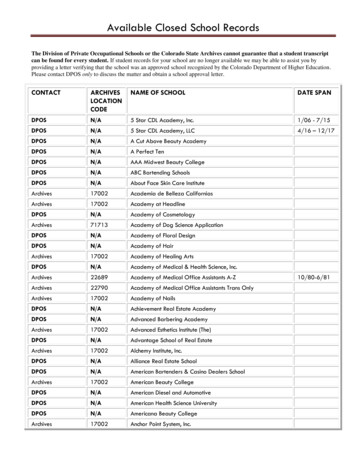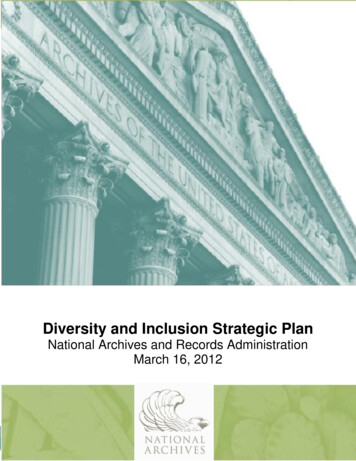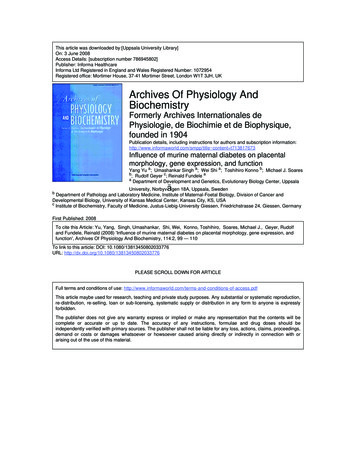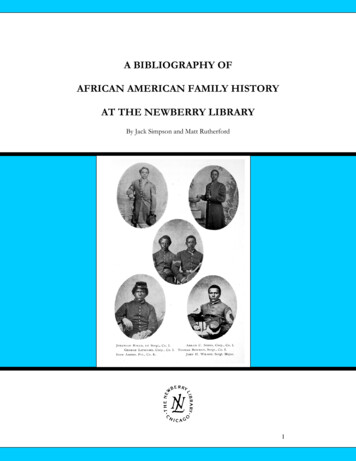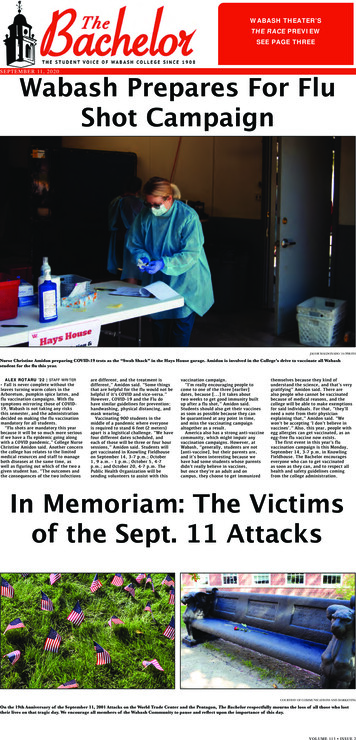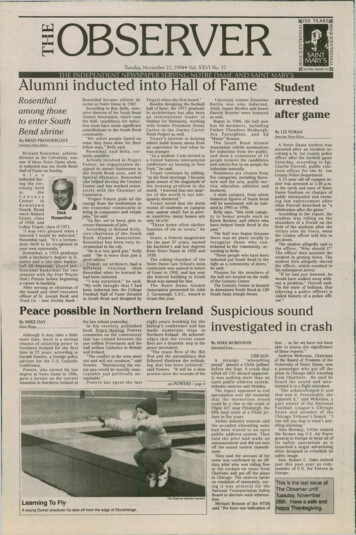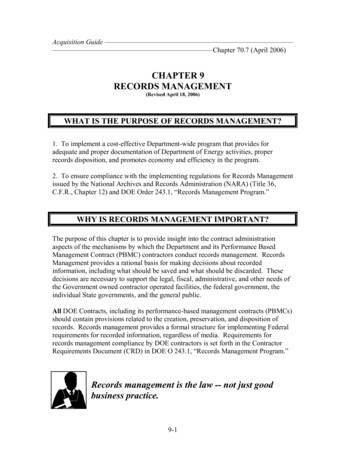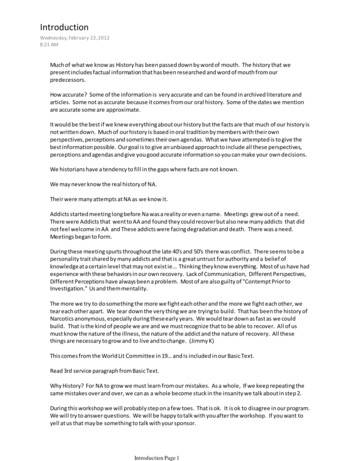
Transcription
IntroductionWednesday, February 22, 20128:21 AMMuch of what we know as History has been passed down by word of mouth. The history that wepresent includes factual information that has been researched and word of mouth from ourpredecessors.How accurate? Some of the information is very accurate and can be found in archived literature andarticles. Some not as accurate because it comes from our oral history. Some of the dates we mentionare accurate some are approximate.It would be the best if we knew everything about our history but the facts are that much of our history isnot written down. Much of our history is based in oral tradition by members with their ownperspectives, perceptions and sometimes their own agendas. What we have attempted is to give thebest information possible. Our goal is to give an unbiased approach to include all these perspectives,perceptions and agendas and give you good accurate information so you can make your own decisions.We historians have a tendency to fill in the gaps where facts are not known.We may never know the real history of NA.Their were many attempts at NA as we know it.Addicts started meeting long before Na was a reality or even a name. Meetings grew out of a need.There were Addicts that went to AA and found they could recover but also new many addicts that didnot feel welcome in AA and These addicts were facing degradation and death. There was a need.Meetings began to form.During these meeting spurts throughout the late 40's and 50's there was conflict. There seems to be apersonality trait shared by many addicts and that is a great untrust for authority and a belief ofknowledge at a certain level that may not exist ie Thinking they know everything. Most of us have hadexperience with these behaviors in our own recovery. Lack of Communication, Different Perspectives,Different Perceptions have always been a problem. Most of are also guilty of "Contempt Prior toInvestigation." Us and them mentality.The more we try to do something the more we fight each other and the more we fight each other, wetear each other apart. We tear down the very thing we are trying to build. That has been the history ofNarcotics anonymous, especially during these early years. We would tear down as fast as we couldbuild. That is the kind of people we are and we must recognize that to be able to recover. All of usmust know the nature of the illness, the nature of the addict and the nature of recovery. All thesethings are necessary to grow and to live and to change. (Jimmy K)This comes from the World Lit Committee in 19 and is included in our Basic Text.Read 3rd service paragraph from Basic Text.Why History? For NA to grow we must learn from our mistakes. As a whole, If we keep repeating thesame mistakes over and over, we can as a whole become stuck in the insanity we talk about in step 2.During this workshop we will probably step on a few toes. That is ok. It is ok to disagree in our program.We will try to answer questions. We will be happy to talk with you after the workshop. If you want toyell at us that may be something to talk with your sponsor.Introduction Page 1
1840Tuesday, February 21, 20127:19 PMWashingtonians founded b y 6 hard drinkers April 2nd 1840. The idea was that by relying on each other,sharing their alcoholic experiences and relying upon divine help, they could keep each other sober. Totalabstinence from alcohol was their goal. Members sought out other drunks and shared theirexperiences with alcohol and how the Washingtonian's had helped them achieve sobriety.Washingtonians numbers in tens of thousands. In just a few years, they all but disappeared. They losttheir primary purpose by becoming involved with other issues besides sobriety such as the temperancemovement, prohibition, religion, politics and slavery. Loosing their primary purpose of helping theindividual alcoholic destroyed them.The fall of the Washingtonians is a direct reason and linked to AA and the Twelve Traditions and that AAneeded to avoid outside, controversial issues that would take away from their focus, their singleness ofpurpose of helping alcoholics stay sober. AA learned from the Washingtonians and their own mistakesto stay away from the public arena. We in NA continued this important philosophy of no opinions onoutside issues.Up to 1949 Page 2
1935Wednesday, February 22, 20129:01 AMOxford groups and their 6 steps. Oxford groups in US having some success working with alcoholics.May 25th-.U.S. Public Health Service Hospital in Lexington, Kentucky. Opened . It became known as the“Narcotics Farm” or “Narco,” This was a prison hospital treating people addicted to narcotics who hadbeen sentenced for federal drug crimes and those who had applied for voluntary treatment. Eventuallypeople that completed this program learned that the AA program could be successfully applied to otherdrug addictions.Medical science had no clue about treating addiction and had no idea what to do with these addicts butbegan developing a treatment program. We don't know what went on in these early days but I think weimagine.June 10th AA born through the meeting of Bill Wilson and Bob Smith.Up to 1949 Page 3
1936Wednesday, February 29, 20124:52 PMReefer Madness American propaganda exploitation film revolving around the melodramatic events thatensue when high school students are lured by pushers to try "marijuana" — from a hit and run accident,to manslaughter, suicide, attempted rape, and descent into madness. The film was directed by LouisGasnier and starred a cast composed of mostly unknown bit actors.Up to 1949 Page 4
1938Saturday, February 25, 20129:38 PMUS public Hospital in Fort Worth Opens to treat Opiate Addicts.Up to 1949 Page 5
1937Wednesday, February 29, 20124:52 PMUp to 1949 Page 6
1938Friday, May 04, 20121:01 PMUp to 1949 Page 7
1939Thursday, February 23, 20127:41 PMDr. Tom entered the Lexington program for a 12 year morphine addiction. While there he found thenewly published Big Book of AA. He returned to Shelby, NC and started an AA meeting. He seems tobe the first known person to recover from opiate addiction using the steps of AA. AA General serviceoffice used the Shelby group as to respond to inquiries about drug addiction.Up to 1949 Page 8
1940Friday, March 02, 201210:34 AMUp to 1949 Page 9
1941Friday, March 02, 201210:34 AMUp to 1949 Page 10
1942Friday, March 02, 201210:35 AMUp to 1949 Page 11
1943Friday, March 02, 201210:35 AMUp to 1949 Page 12
1944Wednesday, February 22, 20129:01 AMBill Wilson gives talk at Yale and is asked if there is a program similar to AA for Addicts/drugs.“Doc N.” wrote a letter to the AA Grapevine in 1944 suggesting a “hopheads corner” in the Grapevinewhere AA members who were also recovering from narcotic addiction could share their experience,strength and hope.Docs letter followed by a series of Grapevine articles centered around drugs including narcotics,sedatives, tranquilizers and amphetamines. These Grapevine articles became the basis for a series of AApamphlets, beginning in 1948 with Sedatives: Are they an A.A. problem?1944-Houston S. found permanent sobriety within AA in Montgomery, Alabama,While In Montgomery, Houston helped a man who was addicted to both alcohol and morphine. Aformer Patient of the Lexington facility this man was able to stop drinking in AA, but was unable torecover from his morphine addiction. Houston became interested in Dual problems.Up to 1949 Page 13
1945Tuesday, February 21, 20128:03 PMBill Wilson writes an AA pamphlet on "Goofballs" warning members about the dangers of “goofballs” inwhich he shared that he had once nearly killed himself with chloral hydrate. I believe in this pamphlet itexplains that addicts that have a drug and alcohol problem are welcome at closed and open AAmeetings. Addicts that did not drink are welcome at open meetings.World War II ends in 1945. AA began to see a large influx of mostly opiate addicts begin to attend theirmeetings. Many of these addicts are from the Asian theatre of WW II. AA not sure what to do with thisinflux. In the next 10 years there will be 3 different Addicts Anonymous/ Narcotics Anonymousorganizations started.Sometime in the mid 40's an Addicts Anonymous is formed in East La. Died out quickly because theywere dominated by one man.Addict meetings were forming in the mid 40's but they were mostly hidden, underground, back then.Two or three people meeting in apartments. No one new where they were. These meetings weremostly dominated by one or two personalities. They sprang up and then they died. There was muchstigma attached to being an addict and hiding from police.Houston S in Alabama Works with Harry. Harry relapses Houston becomes interested in dual diagnosispeople alcohlic/addicts.As I see it: Several personalities started drug programs to help with their own addictions. They seemedto be more about trying to get people of drugs rather than sharing their experience, strength and hope.Much like Bill Wilson's experiences until he met DR. Bob and finally shared the message rather than toldthe message.The lesson was learned in NA. No big shots in Narcotics Anonymous.Habit Forming Drugs, HFD (?) I have no starting date.Up to 1949 Page 14
1946Tuesday, February 21, 20127:54 PMDue to internal strife in AA Bill Wilson puts together the 12 Traditions and introduces them to AA. BillWilson began to formulate the Traditions in 1937. The 12 Traditions were originally published in theApril 1946 Grapevine. 1953 "The Twelve Steps and Twelve Traditions" book was published.Dr. Tom suggested the possibility of establishing an AA group for addicts at the U.S. Public Health ServiceHospital in Lexington.September 1946 Houston S is transferred 20 miles from the Lexington facility. Houston gets togetherwith Dr. Vogel the Medical Director at Lexington. They make plans to start a group similar to AA foraddicts. Houston volunteered to help start a group inside the Lexington facility.Up to 1949 Page 15
1947Thursday, February 23, 20128:15 PMFebruary 16th-Houston S. Started a meeting called Addicts Anonymous and met regularly at Lexingtonfrom 1947 until 1966. They aslo called themselves the "Narco Group". Houston stayed involved with thegroup until his health began to fail in 1963. The man that sparked Houston's interest in dual problemseventually found recovery through Lexington.Addicts Anonymous group meetings were voluntary. The meetings followed a format similar to AAmeetings, and personal recovery was based on an adaptive version of the Twelve Steps from AlcoholicsAnonymous."The Key" was an Addict Anonymous newsletter published in Lexington by Addict Anonymous membersworking in the vocational and educational unit. This helped members that had come through theLexington program stay in touch and communicate with each other. "The Key" discussed issues ofconcern to those undergoing treatment in Lexington or who were re-adjusting to life as a person inrecovery.When Narcotics Anonymous (that we know) began in 1953 the Key is referenced and their purpose istaken from the key.Up to 1949 Page 16
1948Thursday, February 23, 20128:37 PM1948 AA pamphlet Sedatives: Are they an A.A. problem? Is publishedIn Fort Worth, Texas the Federal Narcotics Farm adopted the Lexington model. The Lexington model atthat point had become the 12-Steps with the word alcohol changed to drugs in the First Step.After leaving Lexington Danny Carlson, another person unknown (could have been Rae Lopez) and MajorDorothy Berry started a Narcotics Anonymous meeting in the New York Federal Prison System. It seemsto have disappeared shortly. Possibly due to Danny Carlson's relapse. There is a report that Rae Lopezwas involved with this meeting.Up to 1949 Page 17
1949Tuesday, February 21, 20128:15 PMDanny Carlson, born in 1907, had a 25 year opiate addiction, went through the Lexington program 9times. Danny was one of Lexington's first patients in 1935.After a Suicide attempt in 1948 Danny was readmitted to the Lexington facility. At this time Dannybegan participating in Addicts Anonymous meetings. During this time he had a profound spiritualexperience. Danny met Houston S. and wrote "Houston inspired me to learn to hope, and to have faith,at long last"In April 1949 Danny Carlson returned to New York City and started a program called NarcoticsAnonymous to avoid any confusion with AA. These were 12 step based meetings. It is Danny’s effortsthat first brought the NA name to national attention.Danny met Major Dorothy Berry of the Salvation Army at the Women's House of Detention. This waswhere the first meeting of NA was held.Major Berry offers NA the use of the Lowenstein Cafeteria at the Salvation Army located on 46th Streetin an area of New York City known as Hell’s Kitchen.Up to 1949 Page 18
1950Tuesday, February 21, 20128:17 PMDanny Carlson Narcotics Anonymous in New York City. Starts meetings at Rikers Island, New York Citiesmain Jail complex.January 1950-Narcotics Anonymous meetings started for addicts. Major Berry was NA's first patron.She donated a corner of her office as NA's first headquarters.Early meetings have money problems, Meeting space issues and perception problems from thecommunity.Following the closing of the Salvation Army cafeteria, NA meetings were held on the Staten Island Ferryuntil meeting space was found at the McBurney Branch of the YMCA. An open meeting was held everyTuesday night with 10 to 30 persons attending, and a closed meeting (“ex-addicts only”) was held everyFriday night that drew more than 25 persons.During the 1950s and early 1960s, New York NA, as well as the Lexington-based Addicts Anonymous,achieved considerable visibility in prominent newspapers such as the New York Times, New York HeraldTribune, New York Post and Chicago Sun Time, magazines: Saturday Evening Post, Time, Newsweek, LookMagazine, Family Circle, Confidential Magazine and Down Beat Magazine, and in books such asNarcotic Menace, Merchants of Misery, The Junkie Priest, Monkey on My Back, Mainline to Nowhere,Narcotics: An American Plan, and The Addict as a Patient.In 1950 another group started in Lorton, VA outside Washington DC. They called themselves theNOTROL group and they were a 12-Step group started at the Federal Prison. The name Notrol is Lortonspelled backwards.Meeting are reported in Chicago springing from the Lexington facility.in 1950, we also know that there were Habit Forming Drug groups taking place in Los Angeles,California, usually in conjunction with AA meetings. They were also held in homes. The principal personbehind them was a lady named Betty Thom. She did a good amount of writing. They had a 12 Stepguide. They were very committed that the 12 Steps could work for recovery from addiction. No servicestructure. Seemed to be run by Betty Thom. Habit Forming Drugs has a religious atmosphere, tied toAA, no traditions and did not consider themselves a fellowship.Betty Thom writes Habit Forming Drugs 12 SuggestionsBetty Thom Writes-Habit Forming Drugs A Brief Interpretation of the 12 StepsI found some information from oral tradition that around 1950 Jimmy Kinnon and Si Malos refers to agroup called Addicts Anonymous that was taking place in East Los Angeles. Si Milos could be involvedwith this group.January 30th-AA officially adopts the 12 traditions.Feb 22nd-Jimmy Kinnon finds recovery in AA.1950 to 1959 Page 19
1950 to 1959 Page 20
1951Tuesday, February 21, 20127:36 PMFather Dan Egan "The Junkie Priest" ordained in 1945, begins helping street addicts, especially womenaddicts/prostitutes, which became his lifelong mission.After Danny’s passing Father Dan promoted NA in New York City through pamphlets that he wrote inwhich he characterized addiction as a “disease of the whole person – physical, mental, emotional andspiritual"Jan 25th-Danny Carlson applies for the incorporation of NA. Danny is listed as the founder of NA.Danny Carlson creates an organization for NA – the National Advisory Council on Narcotics (NACON) .He organizes an educational support group for the parents of addicts called the Committee for MedicalControl of Narcotics Addiction.NACON board of directors included Marty Mann of the National Committee on Alcoholism and Dr.Marie Nyswander who is later a co-developer of methadone maintenance a drug replacementprogram .New York NA celebrates its first year anniversary and it is reported that six members have achieved ayear of continuous recovery.Jerome Ellison newspaper article "These Drug Addicts Cure One Another" includes the Lexingtonfacility, Dr Vogel, Houston S., Habit Forming Drugs, Danny Carlson and New York NA.Betty Thom Writes Habit Forming Drugs-The Challenge of Drug AddictionBoggs Act Imposed maximum criminal penalties for violations of the import/export and internal revenuelaws related to drugs and also established mandatory minimum prison sentences.1950 to 1959 Page 21
1952Tuesday, February 21, 20127:36 PMAddicts Anonymous meetings start in East La. Dominated by Cy Milos (Also spelled Si Malos). There isno information linking these meetings to Lexington.1950 to 1959 Page 22
1953Tuesday, February 21, 20127:16 PMJune 1st-AA Twelve Steps and Twelve Traditions book publishedIn 1953, NACON was unsuccessful in its attempt to solicit funds to support plans for a publiceducation campaign and developing hospitals for the treatment of drug addiction.Betty Thom writes Habit Forming Drugs-A Discussion on Drug AddictionBetty Thom Writes Habit Forming Drugs-The Addict and The Alcoholic-Betty ThomWilliam S. Burroughs writes the semi-autobiographical novel "Junkie" It has come to beconsidered a seminal text on the lifestyle of heroin addicts in the early 1950s.In the late spring of 1953 the Los Angles Police Department, through Captain Hamilton, contacted amember of A.A. who was involved in A.A.'s Institutional committee. He asked about starting a recoverygroup for addicts. The L.A.P.D. sent a number of people to these first meetings. The person asked wasnot an addict and soon found that he didn t understand them. He didn't understand why the attendeeswere falling asleep. He asked them if he was that boring and they told him that they were just "on thenod." Since he knew nothing of being on the nod, he knew that he had done as much as he knew how todo and was ready to quit. After the third meeting he asked other members of A.A. for help. Cy Milos.had been at the first two meetings, Jimmy Kinnon. attended the third.As in many gatherings of people to help addicts, there was a difference of opinion between Jimmy andCy from the beginning of their involvement. Cy wanted to open the meetings up to people with all typesof problems, Jimmy didn't. Jimmy suggested seeking guidance from A.A. As far as we can tell, these firstthree members were not as involved with illegal drugs as the addicts whom they would be carrying themessage to.AA was mall in the San Fernando Valley at this time. All the key players new each other from AA and itseems that most of them went to the Burbank group. AA groups in general were just starting to see theimportance of the Traditions. The AA 12 and 12 had just come out in 1953.This group continued to meet for about another month.Jimmy and others used to go down to skid row, and meet addicts there who couldn’t identify with thealcoholic in AA Jimmy believed in the steps, and was three years clean when he and some others beganto have preliminary discussions about a fellowship for addicts.There is information in "Miracles Happen" (published by WSO) that Jimmy was in contact with New Yorkand the only thing he liked about New York NA was the name. He had thought about names likeNaranon, Narconon and he realized that Addicts Anonymous would not work due to it be broken downto AA.The NA that we know started. All the NA groups that we know are traced back to one group in 1953 inCalifornia.NA as we know it describes the NA we have today.There were often meetings after the AA meetings where Addicts would sit in the coffee shop and talk1950 to 1959 Page 23
There were often meetings after the AA meetings where Addicts would sit in the coffee shop and talkabout the things they couldn’t talk about in the other meetings.Jimmy was in contact with the folks back in Lexington, Kentucky, not only did he apparently get copiesof the Key but in 1953, some of the old-timers that are still around remember that there was a collectiontaken up. Jimmy Kinnon went back to Lexington, Kentucky to participate in some kind of seminar. Wedon’t really know any more that that except that apparently it did happen.June/July-Discussion starts about forming NA/AA.Jimmy is known in AA as a recovering Alcoholic Addict. Many Rabbit meetings have been held at houseby this time.August 17th 1953, Jimmy Kinnon (3 years clean) and committee of 6, including Guilda Krouse, PatRosenbluth, Jimmy Kinnon, Steve Ryan, Frank Carnahan and Doris Carnahan got together at 10145 StaggSt. at PM for the purpose of organizing an AANA Group. They decide to call it San Fernando ValleyAA/NA. Jimmy chaired this meeting. Jimmy b rings up traditions and that AA won't let them have thatname. He was voted down. Doris was elected secretary at this meeting. Doris and Frank resigned atthe end of the meeting. The three ideas formed at that meetingThe 12 steps would work for addicts as well as alcoholicsThe 12 traditions must be followed if NA was to growThat NA could stand on it's own feet away from AA and not be dominated or affiliated withanything or anybody else.August 31st- there’s an entry in the minutes that our purpose was taken from the Key.September 14th 1953-AA's GSO told them they could adapt the 12 steps but had to change the name.They changed the name to Narcotics Anonymous. They met several times. In these minutes it is saidthey take their purpose from "The Key" the Lexington Kentucky newsletter. This group made acommitment to meet for 1 year on Wednesday nights.We were the first fellowship given permission by AA to adapt there program of 12 steps and 12traditions.September 21st, 1953-This committee met for the last time to work out the details for the first NAmeeting.We know from the very beginning the Narcotics Anonymous that is our fellowship today consists of the12 Steps and the 12 Traditions. The First Step used the word addiction and the word we was used ineach step 1 through 11. We were that way from the beginning. They set it up on purpose.Jimmy's Words about trying to find a meeting place:"It was very hard to find a place to meet; after we got together and agreed what we were going to do.You couldn't find a hall to meet in. Nobody would allow us in. They didn't trust us in any way, shape, orform. And it's pretty sad when you go from one place to another after you've got something real goodgoing and nobody will let you use their hall. You know! Eventually we did find a Salvation Army hall andthey allowed us to use it for five dollars a month. You know, that's pretty good, but there were nofacilities there. There was one little restroom with a hand basin and a bowl in there, and that was it.There was no kitchen, so we had to go out and buy a little electric stove and some coffee pots, somecups - which I still have at home. I found them just this week; I’ve had them all these years. We used togive them to each other because this week you might meet at my place - which is the second picture upthere - and next week we might meet at your place. So you took the cups with you so everybody wouldhave a cup to get their coffee in. You know, not many of us had more than a couple of cups in our houses1950 to 1959 Page 24
have a cup to get their coffee in. You know, not many of us had more than a couple of cups in our housesthen; in tact, not many of us were working. But that's the way it was. I still have those things."I got news for you, the Sunland Lumber Company is now defunct, but we're still living. The SalvationArmy hall is still there - there are 2 pictures if it up on the top line - it is now a Spanish church. Some ofthe other pictures up there are where we had some of our "Rabbit Meetings". We called them "RabbitMeetings" then because we never knew where we were going to meet. If there were 5 or 6 of us at ameeting tonight we decided then whose apartment or whose house we'd have the meeting in next week.And you would take the cups and sugar bowls and the format with you, you know, and then we'd meetat your place next week.It wasn't that we who were getting into the program then were so afraid of the law but the newcomerswere scared to death. I made a sign and we put it outside of the front door of the church there (abouttwice the size of this - three times the size of that) that said NA Meeting tonight at 8:30. And then weopened the door for business and we'd get about a dozen alcoholics in there who came to help us. Andthen a car would pull down around the comer slowly and they'd look at the sign and then they'd split.Nobody trusted nobody - you know they thought it was staked out. They wouldn't believe us when wetold them there was no surveillance. And we weren't just too sure in the beginning ourselves."October 5th 1953-The first NA meeting was held. Space was rented from the local Salvation Army Dad'sClub, Sun Valley, California. Attended by 17 people. These original members made a commitment tocontinue for one year, agreeing that one person recovery would be significant. In attendance:Jimmy KPaul RJoanne PJane Von HJess LGil Von HEllen PJames SJames D.CFrank CGilda KCharles D3 names that can not be read on the sheet. There was a report that Penny K was at the firstmeeting but I have no evidence.December 16th-December 16. 1953, Jimmy Kinnon, Doris and Frank Carnahan all resign from thefounding committee. Everyone had resigned with in the first 6 months.A set of by laws were written from those minutes.We consider Jimmy one of the founders because he is the guy that stuck it out. He kept picking up theball. Jimmy dedicated his life to helping addicts. Jimmy himself did not want to be known as thefounder of NA. Jimmy was quick to let it be known that there were no big shots in NA. This is a "WeThing." Jimmy had a vision of a fellowship like AA that was independent of AA, and World Wide. Everytime Na faltered or fell in the4 50's Jimmy was there to pick it back up. He never quit or gave up. Himand three other addicts picked things back up in 1960 and began the NA we no of today. An NA thatfollows the traditions, has a common structure, is a fellowship and worldwide. That is why I considerJimmy the founder of NA. There were many individuals involved in the 50's but Jimmy is the one withthe vision and the tenacity to keep the vision alive when many times there appeared that there was nohope of a fellowship called Narcotics Anonymous becoming a reality. Most of these other addicts couldnot get past their relationship with AA and could not see NA as it's own entity, it's own fellowshipseparate from AA.1950 to 1959 Page 25
separate from AA.During the 50's there were a lot of controlling personalities that would take over and begin running theshow.Rabbit Meetings through the 50's- Jimmy K " We called them "Rabbit Meetings" then because we neverknew where we were going to meet. If there were 5 or 6 of us at a meeting tonight we decided thenwhose apartment or whose house we'd have the meeting in next week. And you would take the cupsand sugar bowls and the format with you, you know, and then we'd meet at your place next week."I have heard it shared by some members that they do not think Habit Forming Drugs, and New York NAis part of our history. I disagree. Jimmy was in contact with these groups and learned from them.Jimmy went to meetings at Betty Thom's house. He did not like it. To many have to's and no traditions.He had contact with Danny Carlson and liked the name "Narcotics Anonymous" He did not like anythingelse about the New York program but he liked the name.The big lesson learned during this time was that it was important to follow the traditions. Theseprograms that were our predecessors were important to our survival and learning from their mistakes.They taught us that a service structure was indispensable to long term growth.Early Members from this timeJack PEddie CCy MPat RSteve RJmmy KPenny KFrank CDoris CScott K1950 to 1959 Page 26
1954Wednesday, February 22, 20128:43 AMMarch 1954 Letter from Bill Wilson to Betty Thom. Bill notes the Aversion of AA members to Dopeaddicts and Visa Versa.HFD (Habit Forming Drugs) meetings-Betty ThomNew York NA reports a total of 90 members have achieved stable, drug-free living.Winzell Brown writes a book, “Monkey on my Back” and it has a chapter in it called NarcoticsAnonymous, and in that chapter he talks about the meeting at the Salvation Army soup kitchen in NewYork.The Key is has a mailing to over 90 people in almost every state.Danny Carlson and the New York NA group publish "Our Way of Life- An Introduction to NA" pamphlet.Very similar to AA's "A Way of Life" 12 steps are pretty much intact. Drugs replace Alcohol.From California The first NA Unofficial publication "Narcotics Anonymous" was printed. It was brief,only eight pages long. This publication was an information pamphlet containing 20 questions, a briefoutline of NA, the twelve steps and the addresses of the Studio City group and the San Diego group.This is the Yellow Brown Booklet. WSO reports this dare at 1954. I have seen other resource at 1956.Written Mainly by Jack P, with help from Jimmy Knnion and CY Milos. The steps in this booklet includedthe word addiction in the first step, We in front of the first 11 steps, and the word addict in the 12thstep. The is the first evidence we have there were people beginning to develop the disease concept wesubscribe to today. That is that being powerless over the addiction gives us the focus on the causerather than focusing on the sympt
Addicts Anonymous group meetings were voluntary. The meetings followed a format similar to AA meetings, and personal recovery was based on an adaptive version of the Twelve Steps from Alcoholics Anonymous. "The Key" was an Addict Anonymous newsletter published in Lexington by Addict Anonymous
